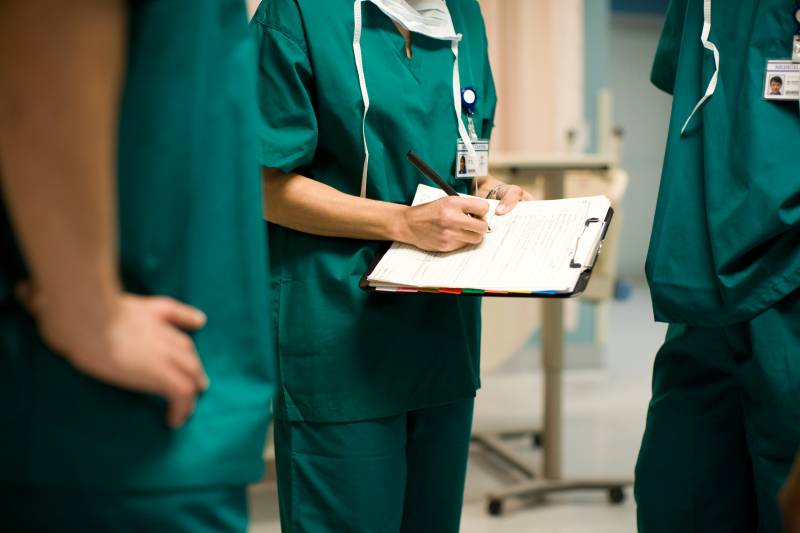“We want to do the best. We work extremely hard to do the best for our patients, so don’t set us up to fail,” Dugan says. “It’s not only nurses — it’s all the other staff. It’s nursing assistants; it’s transport. Every staff member is worried.”
Coronavirus has yet to sicken American health workers, as it has in China. But deaths of hospital workers in Asia have heightened scrutiny of the U.S. health care system’s ability to protect people on the front line.
Dugan says the medical community wasn’t fully prepared for previous viruses, like SARS and Ebola — and she’s concerned that lessons learned are not being applied today. For example: The protective garments provided, she says, leave the wearer’s neck exposed.
“The gowns that they’re providing are inadequate,” she says, with emotion. “I’m sorry — I get very passionate about this, because we’ve worked so hard to make sure that our nurses were protected and therefore they can protect the public.”
UCSF said in a written response to NPR that it has taken multiple “extensive” safety precautions, including isolating sick patients in rooms with special ventilation systems and training staff with proper use of safety gear. In regards to the two coronavirus cases Dugan refers to, UCSF said it briefed the workers who were actually treating the patients. But the hospital does not — as a matter of course — inform general staff of incoming infection cases.
World health officials warn that COVID-19, the disease caused by the new coronavirus, may enter a new phase in the U.S. at some point. Thus far, U.S. hospitals have been able to plan for transfers of incoming patients whose condition is already known. That’s very different from a spreading outbreak, where sick people walk in off the street — a far more difficult scenario for health care workers and the public they treat.
“It’s the unrecognized case that comes through your hospital system or your clinics that really pose the greatest risk,” says Mark Rupp, chief of infectious disease at the University of Nebraska.
Rupp’s hospital is considered a model for managing infections. Its pioneering medical center is one of the few with experience treating Ebola. It has an isolation chamber that filters pathogens, and it practices dry runs, making sure respiration masks fit workers.
Most critically, he says, hospital staff verbally screen patients at the facility’s entrance, asking about symptoms and travel history.
Without that sort of logistical control at a hospital’s entrance, he says, a coughing patient can quickly infect medical staff and other patients waiting in the emergency room or a clinic.
But what about the thousands of other hospitals without extensive experience with the riskiest cases? How are they bracing for a potential outbreak?
Those medical centers are also preparing, says Nancy Foster, vice president of quality and patient safety for the American Hospital Association.
“Everyone I’ve spoken to says they’ve taken substantial steps to make sure they are prepared,” including steps like isolating infectious patients and conserving face masks to ensure supplies last, Foster says.
But not all staff working at those hospitals feel ready.
National Nurses United is conducting an ongoing survey that as of last week found that about 31% of nearly 5,000 nurse respondents said they didn’t have enough protective gear to handle a surge of coronavirus cases. Only 9% said their hospital or clinic had plans to isolate potentially infected patients.
“That’s not high enough for us to feel comfortable,” says Bonnie Castillo, president of the nurses union. She notes that many hospitals are already operating at capacity and that if the coronavirus spreads in the U.S., it will stress the system even more.
“If health care workers and nurses aren’t protected, no one is protected,” Castillo says.
Meanwhile, the White House has requested $1.25 billion in new funding to support preparedness and vaccine development. Congressional Democrats — as well as some Republicans — are calling that amount insufficient.
Copyright 2020 NPR. To see more, visit https://www.npr.org.
9(MDAxOTAwOTE4MDEyMTkxMDAzNjczZDljZA004))

9(MDAxOTAwOTE4MDEyMTkxMDAzNjczZDljZA004))
